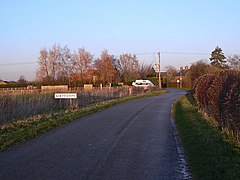
Calverton is a village and civil parish in Nottinghamshire, of some 3,300 acres (1,300 ha), in the Gedling district, about 7 miles north-east of Nottingham, and 10 miles south-east of Mansfield. England, and situated, like nearby Woodborough and Lambley, on one of the small tributaries of the Dover Beck. The 2021 census found 7,579 inhabitants in 3,326 households. About two miles to the north of the village is the site of the supposed deserted settlement of Salterford.

Aslockton is an English village and civil parish 12 miles (19 km) east of Nottingham and 2 miles (3.2 km) east of Bingham, on the north bank of the River Smite opposite Whatton-in-the-Vale. The parish is also adjacent to Scarrington, Thoroton and Orston and within the Rushcliffe borough of Nottinghamshire. The population was recorded as 974 in the 2011 census, doubling to 1,937 at the 2021 census.

Normanton on Soar, formerly known as Normanton-upon-Soar and known locally as Normanton, is a village and civil parish in the Rushcliffe district of Nottinghamshire, England near the River Soar. This historic village is home to one of the last operating chain ferries in the country, the only lived in cruck building in Nottinghamshire and a 13th-century Grade I listed parish Church.
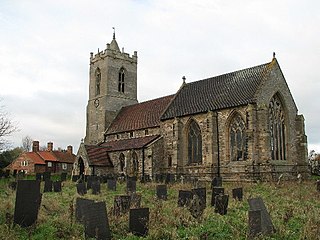
Car Colston is an English village and civil parish in the Rushcliffe borough of Nottinghamshire. The population of the civil parish at the time of the 2011 census was 185, falling to 171 at the 2021 census.

Kingston on Soar is a village and civil parish in the Rushcliffe borough of Nottinghamshire, England.

Stanford on Soar, known locally as Stanford, is a village and civil parish in the Rushcliffe district of Nottinghamshire, England near the River Soar.

West Leake is a small conservation village and civil parish in the Rushcliffe district of Nottinghamshire.

Epperstone is an English village and civil parish in mid-Nottinghamshire, located near Lowdham and Calverton. It had a population of 589 at the time of the 2011 census, falling to 517 at the 2021 census. Many inhabitants commute to work or school in Nottingham 9 miles (16 km) to the south-west.

Flintham is a village and civil parish in the Rushcliffe district in Nottinghamshire, 7 miles from Newark-on-Trent and opposite RAF Syerston on the A46. It had a population of 597 at the 2011 census, estimated at 586 in 2019, and a fall to 563 at the 2021 census. The village name was taken by the Ham class minesweeper HMS Flintham.

Upton is a small village in Nottinghamshire, England, 2 miles (3.2 km) east of Southwell, 5 miles (8.0 km) west of Newark and 3 miles (4.8 km) south of Hockerton; it lies on the A612 Nottingham-Newark road. In 1889, the village was described as sitting on a bend in the main road, "on the summit of a hill which commands a fine view of the Trent Valley.... The church, which is a prominent feature in the landscape, has a substantial Perpendicular tower crowned by eight pinnacles, and having in the centre a lofty master pinnacle which rises above its neighbours, and so adds materially to the effect."

Elston is a village and civil parish in Nottinghamshire, England, to the south-west of Newark, 0.5 mi (800 m) from the A46 Fosse Way. The population of the civil parish taken at the 2011 census was 631, increasing to 697 at the 2021 census. It lies between the rivers Trent and Devon, with the village "set amongst trees and farmland less than a mile from the A46.... Newark is five miles to the north, with... Lincoln and Nottingham some 18 miles north and south-west respectively."

Gonalston is a small village in Nottinghamshire lying just to the north-east of Lowdham and almost upon the A612 trunk road that runs from Nottingham to Southwell. Gonalston comprises 1,096 acres of arable and pasture land in about equal portions, interspersed with 106 acres (0.43 km2) of wood and plantations. It lies on a small river called the Dover Beck which separates the village from Lowdham and which flows south-east into the River Trent 2 miles (3.2 km) away. Population for the 2021 census was 83 residents.

Thoroton is a small English village and civil parish in the borough of Rushcliffe, and the county of Nottinghamshire, with a population of 112 at the 2011 census, and increasing to 130 at the 2021 census. The village has conservation area status. Its Anglican parish church is a Grade I listed building.
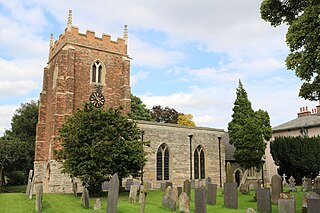
Hawksworth is an English conservation village and civil parish in the Rushcliffe borough of Nottinghamshire. It lies 10 miles (16 km) south of Newark-on-Trent, adjacent to the villages of Flintham, Sibthorpe, Thoroton, Scarrington and Screveton.
Thomas Magnus (1463/4–1550) was an English churchman, administrator and diplomat.
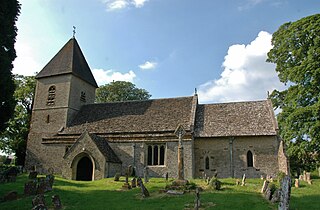
Fritwell is a village and civil parish about 5+1⁄2 miles (9 km) northwest of Bicester in Oxfordshire. The 2011 Census recorded the parish's population as 736.

Syerston is a small civil parish in Nottinghamshire, about six miles south-west of Newark-on-Trent, and is bisected by the A46 trunk road. It contained 179 inhabitants in seventy-three households as reported by the 2011 census, the count has since fallen to 169 residents at the 2021 census, which are almost all in a settlement to the east of the road. The parish is bounded on the north-east by Elston, on the south-east by Flintham and to the east by Sibthorpe. Its southern boundary is the supposed pre-historic trackway called Longhedge Lane.

Screveton is an English civil parish and village in the Rushcliffe borough of Nottinghamshire, with 191 inhabitants at the 2011 census. Screveton singularly reported 164 residents at the 2021 census. It was formerly in Bingham Rural District and before 1894 in Bingham Wapentake. It is adjacent to Kneeton, Flintham, Hawksworth, Scarrington, Little Green and Car Colston.
Raymond Samuel Foster (1920-1987) was born in Bulwell, Nottinghamshire, in 1920. He became an Anglican priest in the 20th century who rose to become Archdeacon of Wrexham.
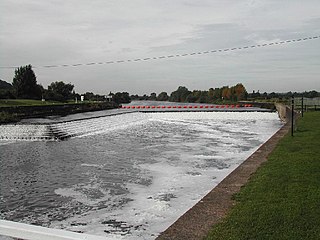
Fiskerton cum Morton is a civil parish in the Newark and Sherwood district, within the county of Nottinghamshire, England. The overall area had a population of 803 at the 2021 census. The parish lies in the south east of the county. It is 112 miles north of London, 12 miles north east of the city of Nottingham, 5 miles west of the town of Newark-on-Trent and 21⁄2 miles south east of the town of Southwell. The parish lies along the bank of the River Trent and is primarily a commuter residential area to both Nottingham and Newark.
